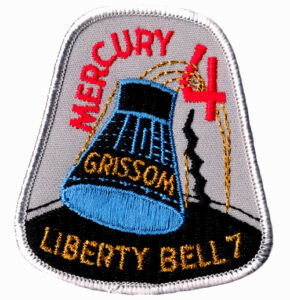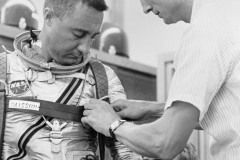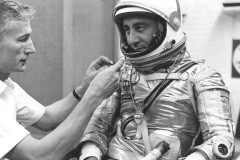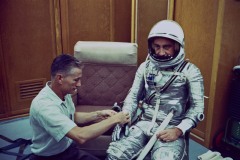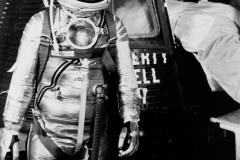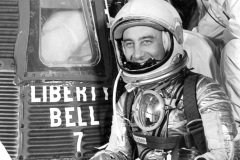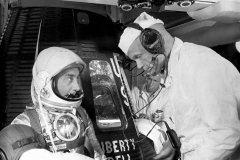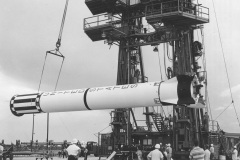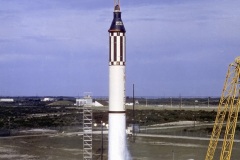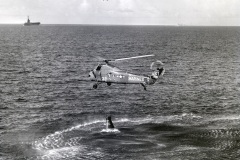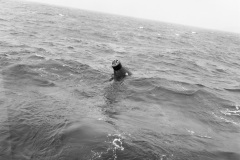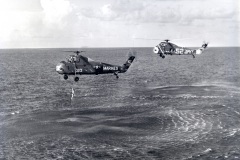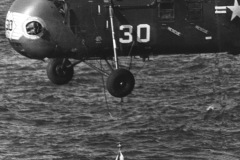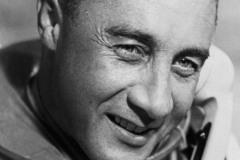Finally, the Redstone rocket took off with Liberty Bell 7 at the head on July 21. After two minutes and 22 seconds, the engine shut down and the spaceship separated from the Redstone rocket. The speed at that time was 2 km/s. For about five minutes, Grissom was in weightlessness.
Grissom was able to rotate the spacecraft on multiple axes. The re-entry into the Earth’s atmosphere occurred at over 11g. After a ballistic flight and reaching the summit altitude of 190 km, an astronaut fired the spacecraft’s braking rockets by hand for the first time. During the descent, Grissom observed cracks in the parachute, but they did not increase. Finally, after a flight of 15 minutes and 37 seconds, Liberty Bell 7 splashed down 486 km from the launch point.
The flight went without any major problems until the splashdown. Helicopters had already flown to the landing site to pick up the astronaut as soon as he exited the landing capsule. Grissom was still in the capsule when the hatch’s explosive device went off, causing water to enter the capsule’s interior.
Grissom had already removed the helmet and the oxygen lines and was able to escape into the sea through the open hatch. If he had still been wearing his seatbelt, he probably would have drowned.
The two pilots of the helicopter that was closest to Liberty Bell 7 managed to hook the landing capsule. They were about to turn to bring Grissom on board when a warning light in the cockpit indicated that the engines were overloaded. A second helicopter was then ordered to Grissom.
At first Grissom had no trouble staying afloat because the air in the spacesuit gave him enough buoyancy. However, this air gradually escaped through the ridge of his neck, and water also flowed through the oxygen pipe connections, making it increasingly difficult for him to swim. He also had extra weight because he had brought a number of souvenirs with him on his flight in the left pant leg of his spacesuit, including two rolls of 50-cent coins for friends’ children, three dollar bills, a few miniature models of the spaceship and two pilot badges. In addition, Grissom was hindered by the waves caused by the rotor wind of the second helicopter. He tried to get help from the helicopters by waving his arms, but the crews initially interpreted it as a greeting from Grissom and waved him back in a friendly manner.
He was able to grab a rescue harness that was thrown to him, with the strap used to rescue Grissom having been put on backwards in a panic and physical exhaustion. Then Grissom could be brought on board. In total, Grissom had spent about four minutes in the water. On the way to the recovery aircraft carrier in the helicopter, he immediately put on a life jacket because he was afraid that if the helicopter had problems he could end up back in the water. On board the aircraft carrier, an officer then handed him his helmet, which must have floated out of the sinking capsule and been recovered by the crew of a destroyer.
In the meantime, the pilots of the first helicopter had given up all attempts to save the capsule. When full, it weighed more than the machine could lift and there was a risk that the engines would be overloaded. Finally, Liberty Bell 7 sank in the Atlantic to a depth of 5,000 meters.
Even though the Liberty Bell was lost, the Mercury spacecraft had proven its ability to fly. Further suborbital test flights were canceled; the next Mercury flight was supposed to take an Atlas rocket into orbit, but initially with a monkey as crew.
After several unsuccessful attempts in 1992 and 1993, on July 20, 1999, on the thirtieth anniversary of the moon landing of Apollo 11, Oceanering International, Inc. succeeded in recovering the Liberty Bell from the Atlantic. At the Cosmosphere (Hutchinson, Kansas), the capsule was dismantled and cleaned and presented on a nationwide exhibition tour through September 15, 2006.
Mission data |
|
|---|---|
Mission |
Mercury-Redstone 4 (MR-4) |
Rocket |
Redstone MRLV, MR-8 |
Spacecraft |
Mercury capsule #11 “Liberty Bell 7” |
Crew |
Virgil I. Grissom |
Launch date |
July 21, 1961 |
Launch site |
Launch Complex 5 (LC-5), Cape Canaveral, Florida |
Mission duration |
15 min 37 sec |
Orbits |
suborbital flight |
Recovered by |
USS Randolph |
Altitude |
190 km |
Distance |
486 km |
Velocity |
8,317 km/h |
Max G |
11.1 g |

